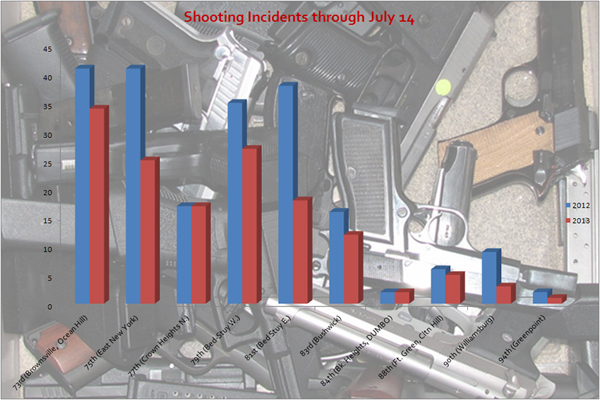
Photo by: NYPD/Murphy
So far this year, shooting incidents have declined or stayed flat in all Brooklyn North precincts.
“Any one of us here alone means nothing, but collectively we form a strong bond,” said Kirsten John Foy late Friday night while standing outside a bodega on the corner of Myrtle and Tompkins Avenue in Bedford-Stuyvesant.
This past Friday and Saturday was the second weekend of the National Action Network’s (NAN) Occupy the Corners campaign where, across the five boroughs, members of Al Sharpton’s network took to the streets at some of the most dangerous corners of the city.
“We’re out here to engage the community and start a dialogue about gun violence, said Foy. “Especially with the younger generation.” Foy, who is running for City Council is also the Chair of the Brooklyn Conference of Chapters for NAN.
Occupy the Corners, now in its second year, began last August in response to the death of Lloyd Morgan, a four-year-old boy who was shot in July 2012 at a Bronx playground.
Taking place every Friday and Saturday night from 11:00 pm to 1:00 am, during the last three weeks in July and the first week of August, Occupy the Corners encourages residents to come out and take back their streets from violence.
Low turnout
Four people, including Foy, were out Friday night for two hours, maintaining a presence on the corner of Myrtle and Tompkins. According to Foy, the largest crowd so far this month has been at the corner of 125 Street and Amsterdam Avenue.
“We disseminate information to those that pass by,” said Tony Herbert, president of the NAN Brooklyn East Chapter, who says they select information on topics such as job employment or youth programs.
This past week members of the Brooklyn East Chapter occupied the corner of Mother Gaston Boulevard and Pitkin Avenue in Brownsville and gave out information on youth programming and youth resources. About 10 people last week participated at their location, said Herbert.
Last year, however, they averaged between 16 to 30 individuals at a time.
Police presence debated
“The more folks and the more organizations that get involved will heighten the sense of the needs of the community,” said Herbert who believes the campaign is effective. “We’re there to make sure that nothing happens,” he said. “We have the police there with us as well.”
Though the intent to deter crime is the overall arching theme of Occupy the Corners, not everyone views the police presence as helpful.
Foy says that the police are a deterrent to communicating with youth. Young people are less likely to stop and engage if police are present, he said. “They just want to go about their business, they don’t want to get harassed.”
Foy says that he and members of NAN appreciate the cops being there and know that they are looking out for their safety, but one of the purposes of Occupy the Corners he said “is to show that community is rising up and taking responsibility and taking the community back. And when the police come out, it negates that.”
Herbert, however, doesn’t see a problem with the police presence. “I don’t feel that. I don’t get it. I want people to see that the police are visible.”
Violence evolves
According to James McDougal, the current president of the Southern Brooklyn Chapter of NAN who was also at Myrtle and Tompkins Avenue on Friday night, gang violence has evolved. In the past there were larger gangs, but more recently there are smaller crews stemming out of NYCHA developments.
“You have more, smaller gangs now. So this: Tompkins against Marcy which is down the block,” said McDougal gesturing across the street towards Tompkins Houses. “Marcy against Marcus Garvey… So that’s what we’re dealing with now.”
A trend identified said McDougal is the connection between gun violence and basketball courts. “We pinpointed something. We did our research that there were at least 30 shootings near or around basketball courts in the last year,” he said.
To address this issue, McDougal said NAN has come up with an initiative called “Hold the Ball,” which will be a seven-day program to address gun violence associated with summer basketball. It will take place August 7-14 at Potomac Park in Bedford-Stuyvesant. A pilot program, it will teach people involved in basketball programs how to keep their parks safe from gun violence. It will also include resources such as resume writing and information on knowing your rights regarding stop-and-frisk. Yoga will be taught to basketball players and kids will have the opportunity to learn how to play the guitar.
At the corner of violence and stop-and-frisk
So far in 2013, the number of shootings citywide is down roughly 30 percent over the same period in 2012. In the 73rd precinct that covers Brownsville, and the 79th precinct that covers the western part of Bed-Stuy, the number of shootings is down a combined 20 percent—there have been 61 in the two precincts so far this year. But that’s still a high level of violence; by comparison, there hasn’t been a single shooting so far this year in Lower Manhattan’s 1st precinct. In Brooklyn Heights/DUMBO, there have been but two shooting.
The debate over stop-and-frisk resonates loudly in Bed-Stuy and Brownsville. The 79th had the fifth most stops in the city last year and the 73rd ranked second, with 88 percent of those stops ending with no arrest or summons. But it’s in high-crime areas like these that the NYPD’s defenders have demanded that stop-and-frisk critics come up with a better way to head off violence. Foy argues that Occupy the Corners is an alternative to aggressive policing.
“It’s got to be a collective. The community has to be united in confronting this,” he said. “We are not going to just abandon our streets to thugs and murderers.”








